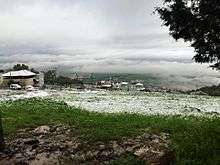Ed-Dahi
| Ed-Dahi דַחִי لدحي | |
|---|---|
| Hebrew transcription(s) | |
| • standard | דַחִי |
|
Ed Dahy Mosque | |
 Ed-Dahi | |
| Coordinates: 32°37′16.1″N 35°20′36.56″E / 32.621139°N 35.3434889°ECoordinates: 32°37′16.1″N 35°20′36.56″E / 32.621139°N 35.3434889°E | |
| District | Northern |
| Council | Bustan al-Marj |
| Population (2015)[1] | 636 |
| Name meaning | the village of Dŭhy[2] |

Ed-Dahi, also spelled ad-Dahi (Arabic: الدحي) or simply Dahi (Hebrew: דַחִי) is an Arab village in north-eastern Israel. Located adjacent to Afula, it falls under the jurisdiction of Bustan al-Marj Regional Council. The village is situated at an altitude of 550 meters above sea level.[3] In 2015 it had a population of 636.
History
The village was named after Dahia Bin Khalifa al-Kalbei, who according to Islamic tradition, was a friend of the prophet Muhammad. Dahia, an ambassador of Muhammad, attempted to convert Byzantine emperor Heraclius to Islam. According to local tradition, Dahia was killed and buried in the site of the village.[3]
Ottoman era
In 1882, the Palestine Exploration Fund's Survey of Western Palestine (SWP) described it as "a little hamlet of stone cabins, on the saddle west of the conical peak of Jebel ed Duhy. Straggling olives exist on the north and west. The water supply is from a well lower down the hill, on the north."[4]
British Mandate era
In the 1922 census of Palestine conducted by the British authorities, Al Dahi had a population of 84, all Muslims,[5] increasing slightly in the 1931 census to 87, still all Muslim, in a total of 16 houses.[6]
In 1945 the population was 110 while the total land area was 8,038 dunams, according to an official land and population survey.[7] Of this, 19 dunams were for plantations and irrigable land, 2,979 for cereals,[8] while 10 dunams were classified as built-up areas.[9]
Present
In February 2016 Bustan al-Marj Regional Council announced that they would be moving their offices from Afula to Ed Dahi. Council chairman Ahmed Zoabi noted "The offices are now located in one of the four villages of the council and this is important".
See also
References
- ↑ "List of localities, in Alphabetical order" (PDF). Israel Central Bureau of Statistics. Retrieved 16 October 2016.
- ↑ Palmer, E. H. (1881). The Survey of Western Palestine: Arabic and English Name Lists Collected During the Survey by Lieutenants Conder and Kitchener, R. E. Transliterated and Explained by E.H. Palmer. Committee of the Palestine Exploration Fund. p. 163.
- 1 2 Dahei Bustan al-Marj Regional Council.
- ↑ Conder, Claude Reignier; Kitchener, H. H. (1882). The Survey of Western Palestine: Memoirs of the Topography, Orography, Hydrography, and Archaeology. 2. London: Committee of the Palestine Exploration Fund. p. 85.
- ↑ Barron, J. B., ed. (1923). Palestine: Report and General Abstracts of the Census of 1922. Government of Palestine. p. 38.
- ↑ Mills, E., ed. (1932). Census of Palestine 1931. Population of Villages, Towns and Administrative Areas. Jerusalem: Government of Palestine. p. 73.
- ↑ Hadawi, Sami (1970). Village Statistics of 1945: A Classification of Land and Area ownership in Palestine. Palestine Liberation Organization Research Center. p. 62.
- ↑ Hadawi, p109
- ↑ Hadawi, p159
External links
- Welcome To al-Dahi
- Survey of Western Palestine, Map 9: IAA, Wikimedia commons